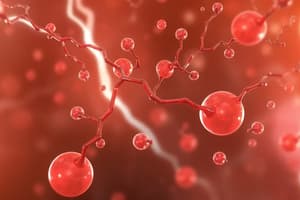Podcast
Questions and Answers
What is the primary initial substrate used in the de novo synthesis of fatty acids?
What is the primary initial substrate used in the de novo synthesis of fatty acids?
- Palmitate
- Acetyl CoA (correct)
- Glucose
- Citrate
Which enzyme is considered the regulatory enzyme for fatty acid de novo synthesis?
Which enzyme is considered the regulatory enzyme for fatty acid de novo synthesis?
- Citrate lyase
- Fatty acid synthase
- Acetyl CoA carboxylase (correct)
- NADPH oxidase
Where does the carboxylation of acetyl CoA to malonyl CoA occur?
Where does the carboxylation of acetyl CoA to malonyl CoA occur?
- In the nucleus
- In the cytosol (correct)
- In the mitochondria
- In the endoplasmic reticulum
What is the final product of the de novo synthesis of fatty acids?
What is the final product of the de novo synthesis of fatty acids?
Which pathway is primarily responsible for the transport of Acetyl CoA from the mitochondria to the cytosol?
Which pathway is primarily responsible for the transport of Acetyl CoA from the mitochondria to the cytosol?
What is required along with Acetyl CoA for the synthesis of palmitate?
What is required along with Acetyl CoA for the synthesis of palmitate?
How many malonyl CoA molecules are produced from seven Acetyl CoA during palmitate synthesis?
How many malonyl CoA molecules are produced from seven Acetyl CoA during palmitate synthesis?
What is the primary function of the carnitine shuttle?
What is the primary function of the carnitine shuttle?
Which enzyme is considered the regulatory enzyme of the carnitine shuttle?
Which enzyme is considered the regulatory enzyme of the carnitine shuttle?
How many ATP molecules are yielded from each cycle of β-oxidation?
How many ATP molecules are yielded from each cycle of β-oxidation?
What is the first step in the β-oxidation process of fatty acids?
What is the first step in the β-oxidation process of fatty acids?
What inhibits the activity of carnitine palmitoyl transferase-I (CPT-I)?
What inhibits the activity of carnitine palmitoyl transferase-I (CPT-I)?
Which molecule acts as an allosteric activator for acetyl CoA carboxylase?
Which molecule acts as an allosteric activator for acetyl CoA carboxylase?
What effect does glucagon have on acetyl CoA carboxylase activity?
What effect does glucagon have on acetyl CoA carboxylase activity?
What is the main source of two-carbon units used in the elongation of palmitate?
What is the main source of two-carbon units used in the elongation of palmitate?
Which state is lipogenesis predominantly active?
Which state is lipogenesis predominantly active?
Which enzyme is crucial for the conversion of free fatty acids into their activated form during lipogenesis?
Which enzyme is crucial for the conversion of free fatty acids into their activated form during lipogenesis?
How does a high-calorie, high-carbohydrate diet affect acetyl CoA carboxylase synthesis?
How does a high-calorie, high-carbohydrate diet affect acetyl CoA carboxylase synthesis?
Which process involves the addition of cis double bonds to fatty acids?
Which process involves the addition of cis double bonds to fatty acids?
What is the role of NADPH in microsomal elongation?
What is the role of NADPH in microsomal elongation?
Which of the following tissues can produce glycerol-3-P from both DHAP and glycerol?
Which of the following tissues can produce glycerol-3-P from both DHAP and glycerol?
What is the role of hormone-sensitive lipase (HSL) in lipolysis?
What is the role of hormone-sensitive lipase (HSL) in lipolysis?
Which substances activate hormone-sensitive lipase (HSL)?
Which substances activate hormone-sensitive lipase (HSL)?
What happens to hormone-sensitive lipase (HSL) when insulin is present?
What happens to hormone-sensitive lipase (HSL) when insulin is present?
Where does β-oxidation of fatty acids primarily occur?
Where does β-oxidation of fatty acids primarily occur?
During which physiological state is fatty acid oxidation most active?
During which physiological state is fatty acid oxidation most active?
What occurs to free fatty acids during lipolysis?
What occurs to free fatty acids during lipolysis?
Which enzyme is responsible for the activation of fatty acids to fatty acyl CoA?
Which enzyme is responsible for the activation of fatty acids to fatty acyl CoA?
What is a characteristic of fatty acid oxidation in the brain?
What is a characteristic of fatty acid oxidation in the brain?
Which pathway does lipolysis NOT influence?
Which pathway does lipolysis NOT influence?
What is the fate of glycerol produced from lipolysis?
What is the fate of glycerol produced from lipolysis?
What is the primary function of lipolysis?
What is the primary function of lipolysis?
Which molecule serves as the initial substrate for lipolysis?
Which molecule serves as the initial substrate for lipolysis?
In which tissue is lipolysis primarily taking place?
In which tissue is lipolysis primarily taking place?
What is the final product of lipolysis from one TAG molecule?
What is the final product of lipolysis from one TAG molecule?
What is the energy yield from the oxidation of fats?
What is the energy yield from the oxidation of fats?
Where does the synthesis of triacylglycerol (TAG) take place in the body?
Where does the synthesis of triacylglycerol (TAG) take place in the body?
Which fatty acid component is typically unsaturated in TAG?
Which fatty acid component is typically unsaturated in TAG?
What happens to TAG in the liver compared to adipose tissue?
What happens to TAG in the liver compared to adipose tissue?
What is the purpose of storing TAG in adipose tissue?
What is the purpose of storing TAG in adipose tissue?
Flashcards
De novo fatty acid synthesis
De novo fatty acid synthesis
The process of creating new fatty acids from smaller building blocks.
Where does de novo fatty acid synthesis occur?
Where does de novo fatty acid synthesis occur?
The primary site of fatty acid synthesis in the body.
What is the initial substrate for fatty acid synthesis?
What is the initial substrate for fatty acid synthesis?
The starting molecule for fatty acid synthesis, produced from glucose breakdown.
What is the rate-limiting enzyme of fatty acid synthesis?
What is the rate-limiting enzyme of fatty acid synthesis?
Signup and view all the flashcards
How is acetyl CoA transported to the cytosol?
How is acetyl CoA transported to the cytosol?
Signup and view all the flashcards
What is the main product of de novo fatty acid synthesis?
What is the main product of de novo fatty acid synthesis?
Signup and view all the flashcards
What is the enzyme responsible for the final steps of fatty acid synthesis?
What is the enzyme responsible for the final steps of fatty acid synthesis?
Signup and view all the flashcards
What is TAG synthesis?
What is TAG synthesis?
Signup and view all the flashcards
Where does TAG synthesis occur?
Where does TAG synthesis occur?
Signup and view all the flashcards
What is lipolysis?
What is lipolysis?
Signup and view all the flashcards
Where does lipolysis occur?
Where does lipolysis occur?
Signup and view all the flashcards
What is the main enzyme involved in lipolysis?
What is the main enzyme involved in lipolysis?
Signup and view all the flashcards
What is the starting molecule for lipolysis?
What is the starting molecule for lipolysis?
Signup and view all the flashcards
What are the products of lipolysis?
What are the products of lipolysis?
Signup and view all the flashcards
What is esterification in TAG synthesis?
What is esterification in TAG synthesis?
Signup and view all the flashcards
What is dephosphorylation in TAG synthesis?
What is dephosphorylation in TAG synthesis?
Signup and view all the flashcards
When does lipolysis occur?
When does lipolysis occur?
Signup and view all the flashcards
How does citrate regulate fatty acid synthesis?
How does citrate regulate fatty acid synthesis?
Signup and view all the flashcards
How does palmitoyl CoA regulate fatty acid synthesis?
How does palmitoyl CoA regulate fatty acid synthesis?
Signup and view all the flashcards
How does insulin affect fatty acid synthesis?
How does insulin affect fatty acid synthesis?
Signup and view all the flashcards
How do glucagon and epinephrine affect fatty acid synthesis?
How do glucagon and epinephrine affect fatty acid synthesis?
Signup and view all the flashcards
How does AMPK regulate fatty acid synthesis?
How does AMPK regulate fatty acid synthesis?
Signup and view all the flashcards
How does diet affect long-term regulation of fatty acid synthesis?
How does diet affect long-term regulation of fatty acid synthesis?
Signup and view all the flashcards
How does a low-calorie diet affect long-term regulation of fatty acid synthesis?
How does a low-calorie diet affect long-term regulation of fatty acid synthesis?
Signup and view all the flashcards
Where does elongation of fatty acid chains take place?
Where does elongation of fatty acid chains take place?
Signup and view all the flashcards
Carnitine Shuttle
Carnitine Shuttle
Signup and view all the flashcards
Carnitine
Carnitine
Signup and view all the flashcards
β-oxidation
β-oxidation
Signup and view all the flashcards
Carnitine Palmitoyltransferase I (CPT-I)
Carnitine Palmitoyltransferase I (CPT-I)
Signup and view all the flashcards
Acetyl-CoA
Acetyl-CoA
Signup and view all the flashcards
What is diglyceride lipase?
What is diglyceride lipase?
Signup and view all the flashcards
What is monoglyceride lipase?
What is monoglyceride lipase?
Signup and view all the flashcards
What is the role of hormone-sensitive lipase in lipolysis?
What is the role of hormone-sensitive lipase in lipolysis?
Signup and view all the flashcards
How do glucagon and epinephrine activate hormone-sensitive lipase?
How do glucagon and epinephrine activate hormone-sensitive lipase?
Signup and view all the flashcards
How does insulin inhibit hormone-sensitive lipase?
How does insulin inhibit hormone-sensitive lipase?
Signup and view all the flashcards
What is the fate of glycerol produced during lipolysis?
What is the fate of glycerol produced during lipolysis?
Signup and view all the flashcards
What is the fate of free fatty acids released during lipolysis?
What is the fate of free fatty acids released during lipolysis?
Signup and view all the flashcards
What is beta-oxidation, and when is it most active?
What is beta-oxidation, and when is it most active?
Signup and view all the flashcards
Why can't red blood cells and the brain use fatty acids as a primary energy source?
Why can't red blood cells and the brain use fatty acids as a primary energy source?
Signup and view all the flashcards
What is the role of acyl-CoA synthetase in fatty acid breakdown?
What is the role of acyl-CoA synthetase in fatty acid breakdown?
Signup and view all the flashcards
Study Notes
Biochemistry II (PB 503) - Fatty Acid, Triacylglycerol, and Ketone Body Metabolism
- This course covers the metabolism of fatty acids, triacylglycerols, and ketone bodies.
- The outline includes de novo synthesis of fatty acids, triacylglycerol synthesis, lipolysis, the carnitine shuttle, β-oxidation of fatty acids, oxidation of odd-chain fatty acids, ketogenesis, and ketolysis.
I. Fatty Acid and Triacylglycerol Synthesis
-
De novo Synthesis of Fatty Acids:
- Occurs in the fed state (stimulated by insulin).
- Primary sites include liver and lactating mammary glands; also in adipose tissue to a lesser extent.
- Location: cytosol.
- Initial substrate: Acetyl CoA (derived from glucose).
- Final product: Palmitic acid (palmitate).
- Requirements: Acetyl CoA, NADPH, CO2, ATP, and biotin.
-
Steps of De Novo Synthesis:
- Step 1: Transport of Acetyl CoA: Acetyl CoA from mitochondria is transported to cytosol via citrate shuttle. Citrate is a high-energy signal. High ATP and high citrate levels enhance the pathway.
- Step 2: Carboxylation of Acetyl CoA: Acetyl CoA is carboxylated to malonyl CoA by acetyl CoA carboxylase (ACC). ACC is a regulatory enzyme.
- Step 3: Palmitate Synthesis: Palmitate is synthesized by fatty acid synthase multienzyme complex. 8 acetyl CoA molecules are needed.
-
Major Sources of NADPH:
- HMP shunt (pentose phosphate pathway): Each glucose molecule entering this pathway yields 2 NADPH.H+.
- Cytosolic malate to pyruvate conversion (by malic enzyme).
- Cytosolic isocitrate dehydrogenase.
-
Regulation of FA Synthesis:
- Allosteric Regulation: Citrate activates and palmitoyl CoA inhibits acetyl-CoA carboxylase (ACC).
- Covalent Modification: Insulin dephosphorylates ACC, activating it and thus increasing FA synthesis. Glucagon and epinephrine phosphorylate ACC, inactivating it and thus decreasing FA synthesis. This is a short-term regulation.
- Hormonal Regulation: Long-term regulation of FA synthesis: Prolonged high-calorie/high-CHO/low-fat diet increases acetyl CoA carboxylase syntheses. Conversely low calorie/low CHO or high fat diet decreases FA synthesis.
II. Fatty Acid and Triacylglycerol Degradation (Lipolysis)
-
Lipolysis:
- Mobilization of stored fats (triacylglycerols or TAGs) in adipose tissue.
- Occurs as a response to the fasting state.
- Takes place in the cytosol of adipose tissue.
- Initial substrate: TAG.
- Final products: 3 fatty acids and glycerol (for energy production).
- Note: The energy yield from fat oxidation is 9 Kcal/g compared to 4 Kcal/g for protein and carbohydrate.
-
Steps of Lipolysis:
- Hormone-sensitive lipase (HSL) breaks down TAGs into diglycerides, monoglycerides, and free fatty acids(FFAs)
- Diglyceride Lipase (HSL) and Monoacylglycerol Lipase (MGL) continues break down to glycerol and FFAs.
- Regulation: Hormone-sensitive lipase (HSL) is the rate-limiting step. HSL is activated when phosphorylated by PKA in response to glucagon and epinephrine, and inactivated by dephosphorylation when stimulated by insulin.
III. Fate of Glycerol and Free FAs
- Glycerol can be used for gluconeogenesis.
- Fatty acids (FFAs) are transported in the blood bound to albumin and are used for β-oxidation.
IV. β-Oxidation of Fatty Acids
- This is the primary process of fatty acid oxidation.
- Occurs in the mitochondrial matrix of most tissues.
- Fatty acid is first activated to fatty acyl CoA and then transported into the mitochondria. This requires carnitine shuttle for long-chain FAs.
- The cycle involves four steps: Oxidation, Hydration, Oxidation, Thiolysis.
- Each cycle shortens the fatty acyl CoA by 2 carbons and yields 1 FADH2, 1 NADH, and 1 acetyl CoA.
- Calculation of the energy yield considers the acetyl CoA molecules, number of cycles and ATP yield from each cycle. The total ATP yield is significantly greater than the ATP required for fatty acid activation.
V. Oxidation of Odd-Chain Fatty Acids
- Proceeds through beta-oxidation as even chain FAs.
- Eventually produces propionyl CoA, which is metabolized into succinyl CoA and utilized in the TCA cycle.
VI. Ketogenesis
- Overview:
- Occurs in the liver in response to prolonged fasting/starvation.
- Location: mitochondrial matrix of the liver.
- Initial substrate: excess acetyl CoA from fatty acid oxidation.
- Final product: 3 ketone bodies (acetoacetate, β-hydroxybutyrate, acetone).
- Steps:
- Acetoacetyl CoA combines with acetyl CoA.
- HMG-CoA synthase is the rate-limiting enzyme.
- Acetoacetate is reduced to β-hydroxybutyrate.
- Acetone can be released from acetoacetate.
VII. Ketolysis
- Overview:
- Occurs in the mitochondrial matrix of extrahepatic tissues (brain, kidneys, hearts, etc.) during prolonged fasting/starvation or other conditions where glucose is not available or insufficient.
- In these tissues, ketone bodies are the primary energy source.
- Steps:
- Ketone bodies are converted into acetyl CoA.
- Acetyl CoA enters the TCA cycle, providing energy.
VIII. Ketone Bodies and Uncontrolled Diabetes Mellitus
- Diabetic ketoacidosis (DKA):
- Characterized by elevated ketone bodies in the blood (ketonemia) and urine (ketonuria).
- Results from insufficient insulin, increasing lipolysis and subsequent ketogenesis.
- Fruity odor on the breath due to increased acetone.
IX. Cholesterol Synthesis versus Ketogenesis
- The initial steps of cholesterol synthesis and ketogenesis share some reactions (steps 1 and 2), but their subsequent fates differ. HMG-CoA is a key branching point. The pathways differ in location and rate-limiting steps.
Studying That Suits You
Use AI to generate personalized quizzes and flashcards to suit your learning preferences.




